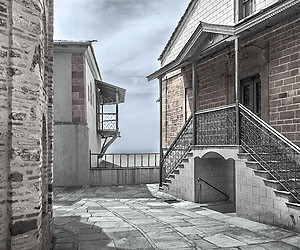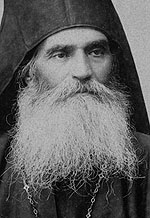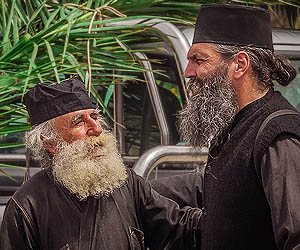The “Avaton” (Restriction of Access) of the Holy Mountain
9 February 20131. The term avaton in general
A fundamental aspect of the monastic profession as made by every monk and nun of the Orthodox Church at their tonsure is the promise to apply bodily restraint, virginity. From this pact stems a series of circumstances and consequences which are usually presented under the term “avaton”.
In the wider meaning of the term there is the prohibition on men entering and staying at women’s monasteries and vice versa, the ban on eunuchs and youths on staying at men’s monasteries, the injunction against keeping female animals in men’s monasteries, the constraints imposed upon monks and nuns as regards leaving their monasteries without good reason and the leave of the superior, and the proscription on fraternization, God-parenthood and guardianship.
Particularly in its narrow sense, that is the prohibition on women entering and staying in men’s monasteries and vice versa, it is very ancient and stems from the very essence of the monastic movement, since abstinence from procreation, in the broad sense, was included in the abandonment by the first anchorites of every material enjoyment.
And so the principle of the avaton is to be found as early as the canons of the Fathers of the Church, Anthony the Great, Pachomius, and Basil the Great, in the form of a prohibition of communication between the two sexes or, in exceptional situations where this was allowed or unavoidable, provisions for a non-scandalous encounter.
This ban found its definitive expression in the legislation of Emperor Justinian. Novella 133, from the year 539, prohibits entry into a monastery by persons of the opposite sex, even of the dead for burial. This arrangement of the novella of Emperor Justinian was repeated without changes or additions in later codified and condensed works.
Much later, Church legislation dealt with the issue of the restriction of entry to members of the opposite sex. Canon 47 of the Quinisext Ecumenical Synod in 692 ordained that no woman was to stay overnight in a men’s monastery, nor a man in a women’s, while, almost a century later, canon 18 of the 7th Ecumenical Synod, in 787, forbade not only overnight stays but any sojourn of any nature at all by women in bishops’ quarters or monasteries.
So the basic line in the official policy of the Church and State which held good in Byzantium, despite the instances where it was broken, was the establishment of the avaton as a form of a reciprocal prohibition, according to which women were unable to enter and remain in men’s monasteries, any more than men could women’s. This ban was universal, since it covered even the dead, and, of course, the living, and not only visitors but even groups who, one might think, would be exempt, such as relatives, members of monasteries belonging to the opposite sex, and, in the case of convents, priests, chanters, and suppliers.
This strict principle was adopted by and underscored in almost all the monastery rules, which desired each house to be “pure”, “inaccessible” and “not overlooked”, as regards the opposite sex. Generally speaking, the author of each rule restricted himself to the monastery for which that rule was destined. For women’s monasteries, it was stressed that men were forbidden to enter or stay therein and the same applied to men as regards convents.
But beyond the expression of the general principle, which in some cases was accompanied by specific punishments in the event of it being breached, the authors of the rules nuanced the prohibition on access with other details which are useful for the better understanding of the practical implementation of the institution. Thus, for example, the Rule of Pakourianos (1083) extends the principle and forbids married couples from living close to the monastery; the Rule of the Monastery of the Kekharitomeni (Our Lady Full of Grace) (1118) explicitly forbids chanters from entering the convent.
This principle of the avaton has always been followed faithfully and without exception by the monasteries on the Holy Mountain from the time of their foundation.
2. The constitutionality of the avaton on the Holy Mountain.
A first and superficial approach would see it as a conflict between the prohibition of women from entering the Holy Mountain and the principle of equality and as a limitation of personal freedom.
The principle of equality, which is enshrined in article 4 of the Constitution, obliges legislators to deal even-handedly with all Greek citizens who are in the same or similar positions and excludes any exception from the general rule in terms of preferential or disadvantageous treatment. The principle of equality does not exclude, however, alternative legislative arrangements for dissimilar or different cases, or those which fall under different or special conditions. On the contrary, in such cases, differential treatment is recognized as being necessary because various special reasons- social, economic, religious and so on- completely justify differential treatment, so long as this differential treatment is objective and founded on general and impersonal criteria.
Something similar applies in the case of the avaton. Women are forbidden entry to the Holy Mountain: all women, without exception. It might be a breach of the principle of equality if entry were permitted only to certain categories of women or to those women who met specific criteria.
And even personal freedom, which, according to article 5§3 of the Constitution is inviolable, is not unrestricted. The Constitution explicitly states that freedom of movement may be restricted when and how the law declares.
So just as no-one thinks to call into question the constitutionality of other restrictions on people’s freedom of movement, such as, for example, entry into an area of military importance, or the ban on hunting or fishing in certain areas or for certain seasons and so on, in the case of the avaton, as far as the law is concerned, there is no question of a breach of the Constitution.
3. The Holy Mountain and the European Union.
How far does the entry of Greece into the European Communities affect the privileged position of the Holy Mountain and, obviously, the principle of the avaton?
The purpose of the Single European Act (signed in Luxembourg and the Hague in February 1986) was the completion of the internal market, a Europe without borders, by December 1992.
This internal market included a space without internal boundaries, in which free movement of people, services, goods and capital was guaranteed.
The privileged position of the Holy Mountain, constitutionally enshrined, presents certain special features which clearly conflict with the single community legal framework. These would be the prohibition on heterodox and schismatics (and, by extension, those of other religions) on the Holy Mountain, the ban on women entering Athos and so on. It is beyond question that such regulations come into direct conflict with the rights of freedom of settlement, freedom of movement and freedom to provide services, all of which are cornerstones of European Community Law.
An overall handling of the problem was attempted by the Joint Declaration on the Holy Mountain, which was signed by the then nine member states of the European Community, which was attached to the Final Act of 29 May 1979 concerning the entry of Greece. The text reads as follows:
“Joint Declaration concerning the Holy Mountain.
Recognizing that the special status granted to Mount Athos, as guaranteed by Article 105 of the Hellenic Constitution, is justified on terms exclusively on the grounds of spiritual and religious nature, the Community will ensure that this status is taken into account in the application and preparation of provisions of Community law, in particular in relation to customs franchises, tax exemptions and the right of establishment”.
It follows from this that the status accorded by Article 105 of the Hellenic Constitution is, since Greece’s accession, part of Community law, and binds all member states, without exception, even those which have since obtained accession. Indeed, in the accession treaties of the new member states, explicit reference is made to their abiding by the foundation treaties of the Community, as these have been amended and expanded. New member states are also obliged to respect the principles and guidelines which stem from the declarations, motions and other positions of the Council and to take those measures which are necessary to ensure their implementation. Such instructions are explicitly included in the accession Act of Sweden, Finland and Austria.
It is well-known that fundamental Community law cannot be amended except by unanimous decisions taken by all member-states and not by the institutional organs of the European Union, which are not empowered to overwrite treaties signed by member-states and ratified by national parliaments.
(Source: Αγιορειτικόν Ημερολόγιον 2012, [Holy Mountain’s Diary] published by the Holy Coenobium Monastery of Xiropotamou, the Holy Mountain).












